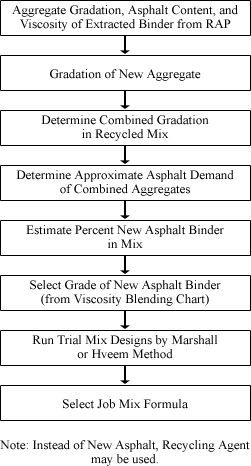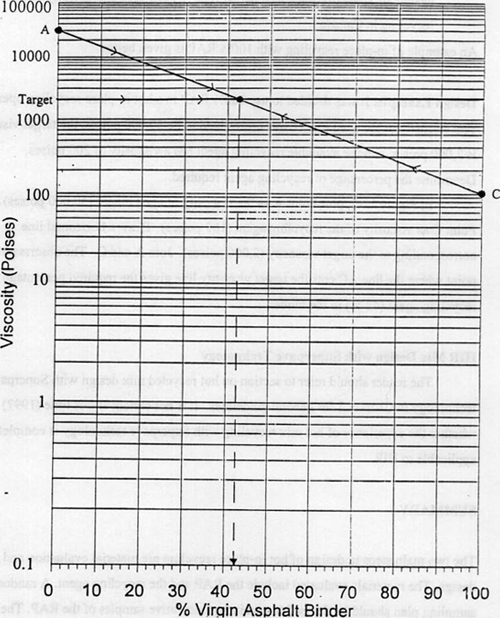ARCHIVED: Chapter 10. Hot In-Place Recycling (Materials And Mix Design)
| << Previous | Contents | Next >> |
Introduction
Hot in-place recycling (HIR) has proven to be a viable technique for rehabilitation of pavements at low cost by using existing in-place materials. The Asphalt Recycling and Reclaiming Association (ARRA) describes hot in-place recycling as an on-site, in-place method that rehabilitates deteriorated asphalt pavements and thereby minimizes the use of new materials.(1) The primary purpose of this process is to correct surface distresses not caused by structural inadequacy, such as cracks, ruts and holes, and shoves and bumps. Basically, this process consists of four steps:
- softening of the pavement surface with heat,
- mechanical removal of the surface material,
- mixing of the material with recycling agent and/or virgin aggregate and asphalt binder, and
- laydown and paving of the recycled mix on the pavement surface.
The advantages of hot in-place recycling are that elevations and overhead clearances are preserved, it is comparatively cheap, and needs less traffic control than the other rehabilitation methods. This process can also be used to recoat stripped aggregates, re-establish crown and drainage and modify aggregate gradation and asphalt content, and improve surface frictional resistance. According to the ARRA guidelines,(2) hot in-place recycling is performed typically to a depth of 20 mm to 40 mm (¾ to 1½ in). Just as in the case of conventional hot mix asphalt (HMA), recycled mixtures must be designed properly to ensure proper performance. When properly designed, recycled mixtures can have properties similar to those of new conventional hot mix asphalt mixtures.(3)
Material Evaluation
The objective of the material evaluation process is to sample, test and determine the important properties of the component materials to come up with an optimum blend of materials to meet the final mix requirements. The process consists of sampling and evaluation of the aged mix (Reclaimed Asphalt Pavement, RAP), the proposed recycling agent, and the proposed virgin aggregate material. For a detailed discussion on different steps of material evaluation, the reader should refer to material evaluation section in chapter 7. In the case of hot in-place recycling the sampling from haul trucks or stockpiles are however, not relevant. The reader should refer to the sampling from pavement sections only.
Mix Design Procedures
Several mix design procedures for HIR are available in the literature. However, these procedures are very similar. The following general steps are recommended for the mix design of hot in-place recycling:(4)
- Evaluation of salvaged materials.
- Selection of type and amount of recycling agent.
- Determination of the need for additional aggregates and/or asphalt binder and/or virgin HMA.
- Preparation and testing of paving mixtures.
- Selection of optimum combination of new aggregates, asphalt binder, and recycling agent or virgin HMA.
The following are the most important steps in mix design.(5) The detailed steps are given in table 10-1.(5, modified by 4)
- Step A. Determine material properties and proportions
- Step B. Prepare materials for mix design
- Step C. Complete mixture design
- Step D. Carry out quality control/quality assurance (QC/QA) tests
Figure 10-1 shows a flow chart recommended for the different steps in mix design of hot in-place recycled mixes.(6) For a detailed discussion on mix design steps the reader should refer to section on mix design procedures in chapter 7. However, the reader should note the following exceptions which are to be dealt in hot in-place recycling:
Figure 10-1. Flow chart of mix design procedure.

- Amount of RAP is generally very high in hot in-place recycling. Whereas 15-20 percent RAP is common in hot mix recycling, in the case of hot in-place recycling 80100 percent RAP is common. If 100 percent RAP is used, it is not necessary to determine any combined gradation of RAP and virgin aggregates.
- Air voids in hot in-place recycled mix can be higher than 4 percent. Higher design air voids (as much as 6 percent) have been used successfully in hot in-place recycling in Canada.
An example of in-place recycling with 100% RAP is given below.
Design Example: It was decided to use 100% RAP in a hot in-place recycling operation. The viscosity of the aged binder was determined to be 50,000 poises, the target viscosity is 2,000 poises, and the available recycling agent has a viscosity of 100 poises. Determine the percentage of recycling agent required.
In figure 10-2, plot Point A as the viscosity of aged binder (50,000 poises) and Point C as viscosity of the recycling agent (100 poises). Draw a horizontal line corresponding to the target viscosity (2,000 poises). Join A and C. The abscissa of the point where the line AC cuts the target viscosity line gives the required percentage of the recycling agent (42 percent) in the binder.
Figure 10-2. Use of asphalt viscosity blending chart (design example).

HIR Mix Design with Superpave Technology
The reader should refer to section on hot recycled mix design with Superpave technology in chapter 7 for general guidelines. It is not certain at this time (1997) whether the experience of hot mix recycling with Superpave technology is completely applicable to HIR.
Summary
The two main steps in design of hot in-place recycling are material evaluation and mix design. The materials evaluated include the RAP and the recycling agent. A random sampling plan should be devised to obtain representative samples of the RAP. The sampling plan and frequency should be decided based on historical, construction, and material data, and if needed, the pavement may be divided into different sub sections before sampling. To evaluate the RAP material, which undergoes changes with time and traffic, its gradation, asphalt content, and rheological properties of aged asphalt binder must be determined. The recycling agent should conform to the applicable AASHTO or ASTM standards. Hot in-place recycled mix design involves the determination of the combined gradation of the aggregates and the required amount of new aggregate, if required, to meet the target gradation. Next, the amount of new (virgin) asphalt binder or recycling agent required in the recycled mix is estimated. Blending charts (based on viscosity or Superpave rutting factor G*/sinδ) are then used to select the grade or amount of virgin asphalt binder or recycling agent. A series of trial mixes are then made with different asphalt contents. The optimum asphalt content for the recycled mix is selected based on Marshall, Hveem, or Superpave volumetric mix design procedures.
| A. Determine Material Properties And Proportions |
|---|
| 1. Obtain representative samples of RAPa, new aggregatesa, and new asphalt cement selectedb. |
| 2. Determine asphalt cement content of RAP (including penetration/viscosity of the recovered binder)b. |
| 3. Determine gradation of RAP aggregate, including bulk specific gravity. |
| 4. Determine gradation, percent crushed, bulk specific gravity, and absorption of new aggregates.c |
| 5. Determine if adjustments in aggregate gradation are necessary to develop voids in mineral aggregate (VMA) and select as necessary, ensuring adequate stability is maintained.d |
| 6. Determine the total aggregate grading, check specification compliance and modify as necessary. |
| B. Prepare Materials For Mixture Design |
| 1. Determine increments (range) of total asphalt content required to develop specified parameter plots. |
| 2. Select recommended grade or preferred penetration/viscosity of new (additional) binder. |
| 3. Determine mass of RAP, new aggregates, and new binder for each increment. |
| C. Complete Mixture Design |
| 1. Prepare compacted briquettes incorporating RAP,e new aggregates, and new binder. |
| 2. Test briquettes - bulk specific gravity, maximum specific gravity, stability, flow, air voids, VMA, and appearance. |
| 3. Report recommended recycled mixture design. |
| D. Quality Control/Quality Assurance (QC/QA) |
| 1. Similar to conventional hot mixture with addition of monitoring RAP (moisture content, gradation, and asphalt-cement content) and more emphasis on absolute viscosity and penetration of recovered binder. |
Notes:
- All samples must be representative. Process control data should be used.
- The new asphalt cement selected must provide properties in the recycled mixture meeting specifications.
- For new aggregates that have not been used before, factors such as petrography and stripping resistance must be considered. This also applies to RAP aggregate, if aggregate-related pavement distress is involved.
- In order to develop VMA, it is often necessary to incorporate a clean, fine aggregate.
- The RAP must be carefully dried during testing to avoid excessive asphalt cement hardening, and then combined with suitably heated new aggregates to give an overall mixing temperature meeting the appropriate combined RAP asphalt cement and new asphalt cement mixing temperature viscosity.
References
- Guideline Specification for Hot In-Place Recycling, Asphalt Recycling and Reclaiming Association, 1988.
- An Overview of Recycling and Reclamation Methods for Asphalt Pavements, Asphalt Recycling and Reclaiming Association 1992.
- J.A. Epps, D.N. Little, R.J. O'Neal, and B.M. Gallaway. Mixture Properties of Recycled Central Plant Materials, American Society for Testing and Materials (ASTM), STP 662, Philadelphia, PA, 1977.
- J.W. Button, D.N. Little, and C.K. Estakhri. Hot In-Place Recycling of Asphalt Concrete, Synthesis of Highway Practice 193, TRB, National Research Council, Washington, DC, 1994.
- J.J. Emery. Asphalt Concrete Recycling in Canada. Proc. 36th Annual Conference of Canadian Technical Asphalt Association, Vol. XXXVI (1991).
- Asphalt Hot-Mix Recycling. The Asphalt Institute Manual Series No. 20 (MS-20), Second Edition, 1986.
| << Previous | Contents | Next >> |

